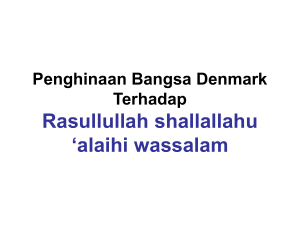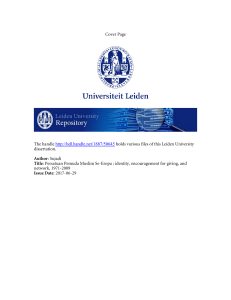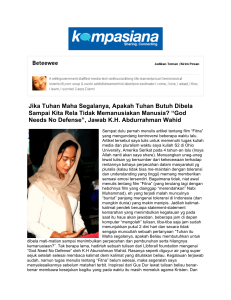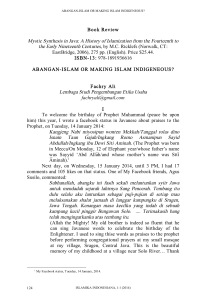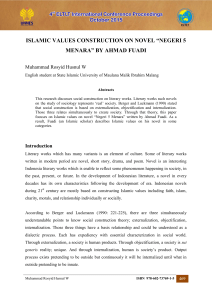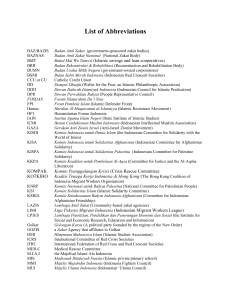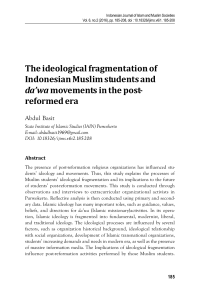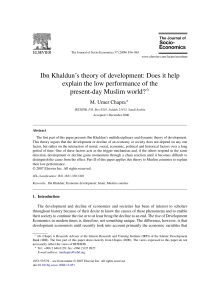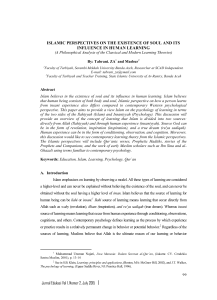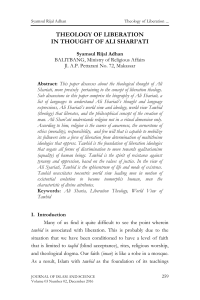Uploaded by
Roza Puspita
Debating Cultural Differences: Ayaan Hirsi Ali on Islam and Women
advertisement
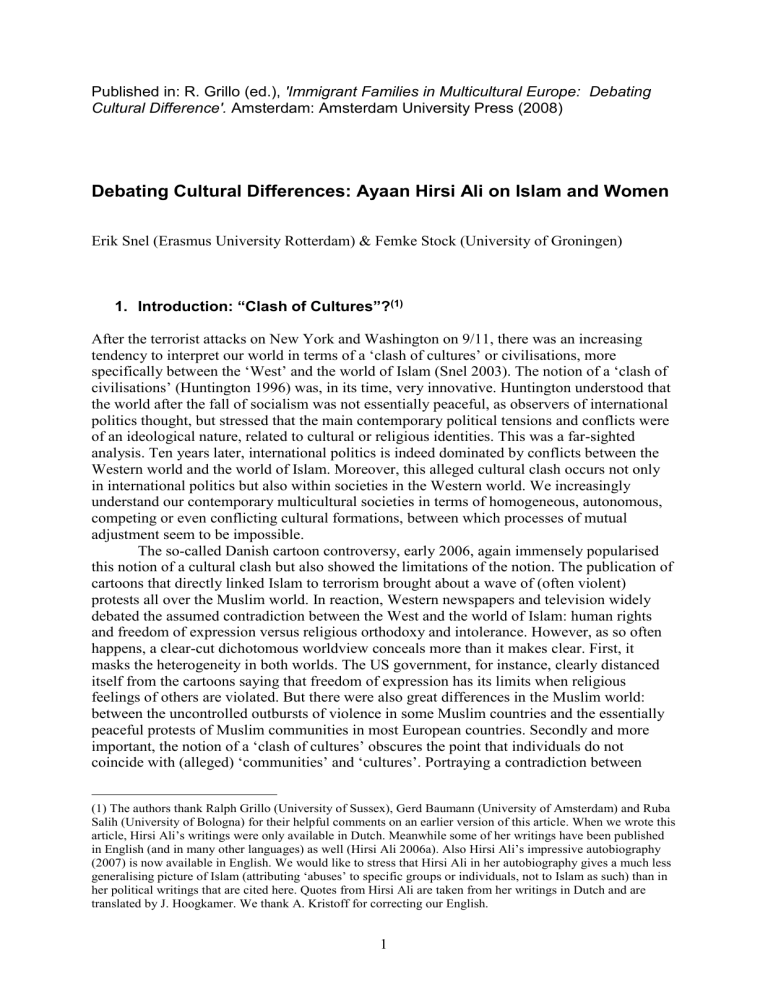
Published in: R. Grillo (ed.), 'Immigrant Families in Multicultural Europe: Debating Cultural Difference'. Amsterdam: Amsterdam University Press (2008) Debating Cultural Differences: Ayaan Hirsi Ali on Islam and Women Erik Snel (Erasmus University Rotterdam) & Femke Stock (University of Groningen) 1. Introduction: “Clash of Cultures”?(1) After the terrorist attacks on New York and Washington on 9/11, there was an increasing tendency to interpret our world in terms of a ‘clash of cultures’ or civilisations, more specifically between the ‘West’ and the world of Islam (Snel 2003). The notion of a ‘clash of civilisations’ (Huntington 1996) was, in its time, very innovative. Huntington understood that the world after the fall of socialism was not essentially peaceful, as observers of international politics thought, but stressed that the main contemporary political tensions and conflicts were of an ideological nature, related to cultural or religious identities. This was a far-sighted analysis. Ten years later, international politics is indeed dominated by conflicts between the Western world and the world of Islam. Moreover, this alleged cultural clash occurs not only in international politics but also within societies in the Western world. We increasingly understand our contemporary multicultural societies in terms of homogeneous, autonomous, competing or even conflicting cultural formations, between which processes of mutual adjustment seem to be impossible. The so-called Danish cartoon controversy, early 2006, again immensely popularised this notion of a cultural clash but also showed the limitations of the notion. The publication of cartoons that directly linked Islam to terrorism brought about a wave of (often violent) protests all over the Muslim world. In reaction, Western newspapers and television widely debated the assumed contradiction between the West and the world of Islam: human rights and freedom of expression versus religious orthodoxy and intolerance. However, as so often happens, a clear-cut dichotomous worldview conceals more than it makes clear. First, it masks the heterogeneity in both worlds. The US government, for instance, clearly distanced itself from the cartoons saying that freedom of expression has its limits when religious feelings of others are violated. But there were also great differences in the Muslim world: between the uncontrolled outbursts of violence in some Muslim countries and the essentially peaceful protests of Muslim communities in most European countries. Secondly and more important, the notion of a ‘clash of cultures’ obscures the point that individuals do not coincide with (alleged) ‘communities’ and ‘cultures’. Portraying a contradiction between (1) The authors thank Ralph Grillo (University of Sussex), Gerd Baumann (University of Amsterdam) and Ruba Salih (University of Bologna) for their helpful comments on an earlier version of this article. When we wrote this article, Hirsi Ali’s writings were only available in Dutch. Meanwhile some of her writings have been published in English (and in many other languages) as well (Hirsi Ali 2006a). Also Hirsi Ali’s impressive autobiography (2007) is now available in English. We would like to stress that Hirsi Ali in her autobiography gives a much less generalising picture of Islam (attributing ‘abuses’ to specific groups or individuals, not to Islam as such) than in her political writings that are cited here. Quotes from Hirsi Ali are taken from her writings in Dutch and are translated by J. Hoogkamer. We thank A. Kristoff for correcting our English. 1 ‘Western’ values such as freedom of speech and ‘Islam’ denies the fact that individual Muslims may identify with both. As a Dutch Member of Parliament of Moroccan descent put it: ‘Muslims and immigrants are only seen as a collective. [The] individual is the greatest victim, because his freedom of identity is at stake. In a false contradiction between ‘civilisation and barbarism’, Muslims have to choose in favour of or against their family, religion and their own threatened identity’(Azough 2006).(2) This paper is not another commentary on the Danish cartoon controversy, but deals more generally with the use of essentialist notions of culture in public and political debates about migrants and multiculturalism in contemporary Europe. We focus on a specific issue, the public debate about women and Islam, and particularly on the contributions to this debate by a former Dutch member of parliament, Ayaan Hirsi Ali. If there is one topic suitable to be discussed in terms of dichotomous stereotypes – the West versus Islam, modernity versus premodern cultures, human freedom versus tradition – it seems to be the position of women in Islam and in Muslim communities. In the few years that Ayaan Hirsi Ali was active in Dutch politics, she caused a huge commotion in public and political debates in the Netherlands. On the one hand she was celebrated as the Netherlands’ most influential parliamentarian, someone with the courage to reveal the abuse of women in Muslim communities and the crisis of multicultural society in general. On the other she was heavily criticised by members of the Dutch Muslim community, including the Muslim women for whom she was fighting, for stereotyping Muslims as traditional, pre-modern, unfriendly or even hostile towards women, etc. She began her public career with a number of much-debated publications about the abuse of Muslim women. In 2004 she made the film Submission with the Dutch filmmaker and well-known critic of Islam, Theo van Gogh. Shortly after the first (and last!) showing of the film on Dutch television, Van Gogh was brutally murdered by a Muslim extremist who defended his action on religious grounds. Hirsi Ali was also threatened and went into hiding for several months. Before we describe Hirsi Ali’s view on the issue of women, Islam and the family, we will outline the Dutch debate about immigrants, Muslims and multiculturalism since the turn of the millennium in more general terms. Hirsi Ali’s critique of Muslims and multiculturalism was not unique, but fitted into a widespread anti-multiculturalist public discourse – Grillo (2005) called it the ‘backlash against cultural diversity’ – in the Netherlands. We then analyse Hirsi Ali’s public statements about women and Islam, and end by demonstrating the (implicit) essentialist or culturalist notion of culture in her work. We will argue that this essentialist or culturalist notion of culture, however popular it may be in current public debates about migration and multiculturalism, is heavily criticised and actually seen as outdated in cultural anthropology, the academic discipline long associated with the study of cultural diversity. 2. Radical Shifts in Dutch Debates about Immigration and Integration Grillo (2005) pointed out the ‘backlash against cultural differences’ occurring in many European countries. In the aftermath of terrorist attacks in New York and Washington (2001), Madrid (2003) and London (2005) there was a growing scepticism about or outspoken criticism of the idea of a multicultural society. The old notion of multiculturalism as an enrichment of European societies suddenly made way for a new discourse emphasising the (2) In a similar way Baumann (1996: 124) pointed out that the Rushdie affair placed Muslims in the UK in the impossible dilemma of having to choose between Islam or freedom of speech. Baumann observed that many Muslims were reluctant to discuss this dilemma. 2 distinctiveness and separateness of immigrant cultures. In this new discourse, cultural differences were equated with problems and multicultural society was perceived as a ‘fiasco’ (Scheffer 2000 [2003]). Grillo describes the rise of this new anti-multiculturalist discourse in the UK, France and Italy, but it is not hard to see similar arguments in recent Dutch debates about immigration and immigrant integration. In the 1980s and 1990s, the Netherlands was internationally well known as an example of multicultural tolerance. The Netherlands not only welcomed foreign immigrants, but also urged them to retain their own cultural identities. ‘Integration with preservation of culture’ was the motto of Dutch policy for many years. Already in the early 1990s however, Frits Bolkestein, subsequently EU-commissioner, gained attention as a critic of the multicultural model of Dutch ethnic minorities policies. Simultaneously with the Rushdie affair in the UK, Bolkenstein stressed the inherent incompatibility between the ‘world of Islam’ and the liberal principles of Western society with regard to freedom of speech, the emancipation of women and homosexuals, and so on. Bolkenstein not only called for harder immigrant integration policies (‘with guts’), but was also the first Dutch opinion leader that stressed the cultural aspects of immigrant integration (Bolkenstein 1991; Ghorashi 2003; Prins 2004). Although his ideas were widely discussed, they were of little influence on the Dutch political debate at that time. The shift in public opinion began shortly after the turn of the millennium when Paul Scheffer, a prominent member of the Dutch Labour party, published a much-debated newspaper article entitled The Multicultural Fiasco (Scheffer 2000 [2003]). In this article Scheffer distanced himself from the (until then predominant) optimism about multiculturalism and immigrant integration, warning of the rise of an ‘ethnic underclass’ in Dutch cities, but also shifted attention in the immigration debate from economic to cultural issues. The issue is not only poverty and unemployment of migrants: ‘Beneath the surface of public life there is a sea of stories about the clash of cultures which are barely heard’ (Scheffer 2003: 26). Although Scheffer’s article initially encountered mainly criticism, it is now generally seen as the start of a dramatic turnaround in the Dutch political debate about immigrants and multiculturalism. Meanwhile, Pim Fortuyn already had started his unprecedented advance in Dutch politics. In the late 1990s, Fortuyn was still a rather marginal academic figure, known for his anti-immigrant and anti-Muslim columns in conservative journals (Pels 2003). He also wrote a book against what he saw as the threatening dominance of Muslim culture in the Netherlands (Against the Islamification of Culture, 1997). After 9/11, there was more attention for his radical views, and in the run-up to the 2002 national elections Fortuyn suddenly emerged as the most prominent critic of the then social-liberal government that had been in power for eight years. Although his anti-immigrant standpoint was not a major part of his political program, it was clear enough to mobilise a huge electorate. Fortuyn became famous for calling Islam ‘a retarded culture’(3), and in a new book against the social-liberal government of that time he stated that Muslims could be dominant in their part of the world but that ‘we’ are in charge in our part of the world (Fortuyn 2002: 154). In other words, immigrants were welcome as long as they rejected their ‘retarded’ culture and assimilated in Dutch society. Fortuyn completely dominated the 2002 national election campaign, but was assassinated shortly before the elections. Despite his tragic death his party and other centreright parties won the elections convincingly, ending almost a decade of liberal and socialdemocratic government in the Netherlands. Dutch political commentators often refer to the (3) In an interview in the Volkskrant (9 February 2002), Pim Fortuyn stated: ‘I do not hate Islam. I find it a retarderd culture. I have travelled a lot in the world. Everywhere where the Islam rules, it is terrible’ (reprinted in Wansink 2004: 291). 3 sudden rise of Pim Fortuyn in Dutch politics as the ‘citizens revolt’. Later electoral research showed that it was mainly his anti-immigrant standpoint that attracted the electorate.(4) After Fortuyn’s death, a young woman of Somalian descent, Ayaan Hirsi Ali, became the most prominent spokesperson for the ‘multicultural backlash’ in the Netherlands. In 1992, Hirsi Ali sought and found asylum in the Netherlands after she had been married off against her will. After graduating from a Dutch university, she started to work for the scientific bureau of the Dutch social-democratic party (PvdA). During her studies she jobbed as a translator in abortion clinics and in women’s shelters. That is where she noticed, as she later wrote, that the shelters were ‘full of Muslim women’ and she became involved in the issue of their abuse. However, in her opinion her employer – the Dutch social-democratic party – did not welcome her activism around this issue because the party was ‘taken hostage by adherents of multiculturalism on the one hand and Muslim conservatives on the other’ (Hirsi Ali 2002c).(5) After she left the social-democratic party, Hirsi Ali was elected as a member of parliament for the Dutch liberal party (VVD), which in fact is not liberal in the American or British sense of the word but rather conservative (especially after the 2002 Fortuyn revolt). In her subsequent contributions to Dutch public and political debate and in her numerous newspaper articles, Hirsi Ali was not only highly critical of the abuse of Muslim women but increasingly of Islam in general. In her view, the suppression of Muslim women is directly linked to Islam as a religion (or as a culture, she appears not to distinguish between the two). Her growing aversion to Islam led her to make some controversial statements. In 2003, for instance, she publicly called the prophet Mohammed ‘a pervert’ because he had married a nine-year-old girl (Aïsha).(6) When the ambassadors of Arabic countries officially protested against what they defined as an insult to Islam, her new party leaders reacted that since the Netherlands has freedom of speech Hirsi Ali is free to say these things. One year later, in 2004, Hirsi Ali together with Theo van Gogh produced Submission. The film was a fierce protest against the abuse of Muslim women. The most shocking part (at least for Islamic believers) was the projection of Qur‘an texts on barely covered female bodies. The murder of Van Gogh, Hirsi Ali’s going into hiding, and her many public statements as a prominent member of parliament, made Hirsi Ali a well known public figure, both inside and outside the Netherlands. In 2004, Time Magazine included her in the ‘TIME 100’, its yearly list of the 100 most influential people in the world. In 2006, Hirsi Ali even unintentionally caused the fall of the Dutch cabinet in a complicated case in which the Dutch minister of Immigration and Integration annulled Hirsi Ali’s Dutch citizenship (thus her parliamentary status) because she misled Dutch authorities when she originally applied for asylum by giving a false name. As the Dutch parliament refused to accept this treatment of one of its members, the cabinet lost its parliamentary support. All in all, the years 2002-2004 were an extraordinary period in Dutch politics: with incidents of political violence unknown in modern Dutch political history, with electoral landslides that undermined existing political powers and created new political majorities, and a climate of public opinion that was increasingly characterised by anti-immigrant and anti(4) After the electoral landslide in 2002, political research tried to explain why Dutch voters choose Fortuyn’s party (LPF) to such extent. It showed that LPF-voters were not a specific social category (‘deprived social groups’ or ‘losers of modernisation’). What LPF-voters had in common, was not their social background but their antipathy against further migration and against multiculturalism in the Netherlands (Van der Brug 2003; Wansink 2004: 193-199). (5) Afterwards Hirsi Ali described her switch from the Social-Democratic Party to the Dutch liberal party (VVD) as follows: ‘because the evasive attitude of the PvdA made me sick. That party has closed its eyes to the growing discontent in society. Women’s suppression is not an issue’ (Hirsi Ali 2003: 8). (6) ‘Measured by our Western standards, Mohammed was a pervert. A tyrant. If you don’t do as he pleases, things will end up bad for you. It makes me think of all those megalomaniac dictators in the Middle East: Bin Laden, Khomeini, Saddam’ (Trouw, 25 January 2003; our translation) 4 multicultural sentiments. In this context, it is hardly astonishing that the prevailing ideas in the Netherlands about immigrants and multiculturalism changed dramatically. The unprecedented political violence in the Netherlands, new terrorist attacks by Muslim extremists elsewhere in Europe (Madrid 2003, London 2005), and the many public statements by popular figures such as Fortuyn, Hirsi Ali and many others contributed to a climate in which the contrasts between native Dutch citizens and new Muslim immigrants and their respective cultures were more and more emphasised. This paradigmatic shift in the Dutch debate about immigrant integration can be summarised in four points (Snel 2003). In the 1980s and 1990s, the flawed integration of immigrants and ‘ethnic minorities’ was mainly perceived as a socio-economic phenomenon: the problem was the disadvantaged position of immigrant groups in Dutch society. After the turn of the millennium attention increasingly turned to cultural issues and the (alleged) deviant behaviour and opinions (‘norms and values’) of immigrants and ethnic minorities. In this new way of reasoning, not only did the perception of the nature of the problem change but also the notion of whose problem it was. In the old perspective the flawed integration process of immigrants was seen primarily as a problem to do with immigrants themselves: they were in a disadvantaged position and in need of the help of mainstream society to improve their situation. In the new perspective, the flawed integration process became a problem for society as a whole. There is a growing conviction that Dutch society cannot cope with too many immigrants, with too much cultural diversity, and especially with too much deviant or even violent behaviour on the part of immigrants (read: Muslims). The fear of Muslim terrorism, of course, immensely reinforced this notion that Dutch society as such is at stake. Finally, the new cultural perspective also implied a new direction to look for solutions. This meant not so much emancipation of immigrants by way of socio-economic improvement, but rather cultural adjustment and assimilation. It is emphasised more and more that immigrants have to respect not only Dutch law, but also the basic norms and values of Dutch society. It is in this political and ideological context that Ayaan Hirsi Ali received political prominence, both inside and outside the Netherlands, and formulated and discussed her ideas about the abuse of women in and by Islam. Table 7.1 Integration frames: ‘disadvantage’ versus ‘culture’ Disadvantage perspective Societal sphere? Socio-economic Kind of problem? Disadvantage (low educational levels, weak labour market position) Whose problem? Of immigrant groups Possible solution? Emancipation (Economic improvement) Cultural perspective Culture (behaviour and opinions) Deviant behaviour, ‘Norms & values’ Of the whole society Assimilation (Cultural adjustment) 3. Hirsi Ali on Islam, women and the family Reading Hirsi Ali’s proliferating writings of recent years, one can distinguish three dominant themes in her work: 1) the suppression and abuse of Muslim women 2) her critique of Islam in general, and 3) the apparent inability of governmental policies to accomplish the social integration of immigrants into Dutch society. In Hirsi Ali’s perception, Dutch immigrant integration policies are too soft and neglect, rather than helping to solve the problem of immigrant integration. In line with the new dominant discourse, she frames the problem of immigrant integration primarily in cultural terms. Integration is a cultural problem, was the 5 title of one of her first publications (Hirsi Ali 2002b). Here we will focus on the first issue, the position of women in Muslim families and communities, although we will see that this gradually transforms into a general critique of Islam and of the Dutch government; that it should do more ‘to stop the violence’. In her writings, Hirsi Ali deals extensively with the suppression and abuse of Muslim women. Muslim women suffer greatly restricted freedom, and they are often subjected to religiously legitimised abuse such as female circumcision, forced marriage, repudiation, and domestic violence. This goes even for well-educated Muslim girls who grew up in the Netherlands. After a few years the tremendous pressure of tradition, religion and group culture defeats their personal independence. They are either married off or are subjected to great pressure from the family, which forces them into an arranged marriage. (…) I would call this a matter of arranged rape, which is even legislated in the Netherlands afterwards (Hirsi Ali 2004: 61). For Hirsi Ali, an arranged marriage equals ‘arranged rape’. This forced intercourse on the wedding night is also overcharged with suspicion as to the virginity of the bride. It is in this scenario of distrust and violence that the children of the next generation are conceived and in which they grow up (Hirsi Ali 2004: 13). Marriage, the constitutional act of the family, is thus highly problematic, and Hirsi Ali sees this bad start as symbolic of the entire marital relationship. Furthermore, Hirsi Ali points to the high rates of domestic violence in Muslim families and the disproportionate number of Muslim women in women’s shelters. She directly links violence against Muslim women to traditional marriage patterns: Marriage which is arranged by the family and takes place at a very early age sets up the husband for a serious, not self-appointed charge of a girl he hardly knows. All of this often leads to incomprehension, anger and inadequacy. Furthermore, if you are raised as a man with the idea that a woman may be beaten the step towards using violence proves small. Currently, abused women’s shelters see a large influx of Muslim women (Hirsi Ali 2003: 49). Besides the extreme violence against Muslim women, such as circumcision, ‘arranged rape’, and domestic violence, there is also less excessive, daily violence that affects both women and their children. Hirsi Ali describes the Islamic family as promoting deceit, suppression and violence. She argues that the Muslim lifestyle almost inevitably implies distrust of women, both before and after the wedding: In marriage, the suspicion of the wife continues. As soon as the bride has been deflowered, the husband’s anxiety assumes grave dimensions (…). The only remaining way to prevent her deceiving him is by denying her access to the outside world as much as possible. Every step outside requires his approval or companionship. This is a authority given to him by Allah (Hirsi Ali 2004: 14). This almost unbearable control necessarily evokes deceit: Children are confronted with their mother’s lies on a daily basis. If she were to admit to being outside alone, her husband and mother-in-law would become angry. Lies are common, as is denial. Admitting is no option, this would lead to loss of face and possibly even violence. (…) Children are taught by their mother to invent stories if 6 they not wish to be punished. So, lying is profitable (…) This has a disastrous effect on children raised by these women, especially the boys (Hirsi Ali 2004: 15). In her reflections on all the evil done to Muslim women, Hirsi Ali continuously combines and merges cultural and religious explanations. On the one hand (as already became clear in previous quotations), she argues that Islam as a ‘culture and religion is hostile towards women’ (Hirsi Ali 2003: 7)(7), and legitimises or even reinforces the suppression and abuse of Muslim women. On the other hand she stresses that most Muslim women in the Netherlands originate from traditional regions in their home countries. She refers to ‘the man or woman that walks in from the Rif Mountains or the Anatolia countryside’ (Hirsi Ali 2002a: 178). This cultural explanation of the issue is best phrased in an early article, which was written when Hirsi Ali was still employed by the Dutch social democrats. Here she argues that Muslim migrants are traditional and should be ‘initiated in modernity’: The major part of Muslims that have come to the Netherlands (is) from the countryside, where the tribal tradition still prevails. (…) Their cultural background has three important characteristics. First, a hierarchical-authoritarian attitude. Secondly a patriarchal family structure, in which a woman has a reproductive function and should obey the man; if she does not obey she disgraces the family. The third aspect is the group regulated mindset, in which the group always precedes the individual; there is a strong social control; as well as a fervent guard of the own honour, which makes people obsessed with avoiding disgrace. This traditional mentality is imbued with traditional religious beliefs (Hirsi Ali 2002a: 172). Hirsi Ali particularly points out the ‘mentality of honour’ and the ‘obsession with the maidenhead’, resulting from this mentality, as a source of much misery: Islam demands that you enter your marriage as a virgin. This dogma of virginity is safeguarded by confining girls to their homes and by sowing together their labia majora. Female circumcision serves a dual purpose. The clitoris is removed in order to curtail the sexuality of the women and to guarantee their virginity (Hirsi Ali 2003: 17). Elsewhere, she argues that this obsession with the maidenhead results in ‘human and social catastrophes’: A girl (…) who has lost her ‘seal of being unused’, can no longer find a marriage partner and is doomed to waste away in her parental home for the rest of her life. (…) The family then punishes the girl as well, a punishment that ranges from scolding to disowning or being incarcerated, it can even lead to an arranged marriage. In the worst case she is being murdered (Hirsi Ali 2004: 9). On the other hand, Hirsi Ali is quick to add that these traditional cultural practices are fully incorporated and reinforced in Islam as a religion: These existing local customs have been expanded, strengthened and consecrated by the Islam (Hirsi Ali 2003: 17). About female circumcision she writes: Muslim scholars have never rejected the practice of sewing up labia, because in the Islam, it is considered very important for women to marry as virgins. When they came in contact with tribal customs concerning sewing up women’s labia, they must have thought: “Hey, that is a great way to safeguard virginity. How marvellous!” (Hirsi Ali 2004: 29). (7) Hirsi Ali (2003: 7) in fact stated that the flawed integration to a large extent has to do with Islam as a culture and religion that is hostile towards women. 7 In other words, Islam equals obsession with virginity equals ill treatment of Muslim women. Still more, in this climate of honour, shame and strict sexual morality, families discourage openness and discussion: In Muslim families there is a massive taboo on talking about contraception, abortion and sexual violence. This taboo springs directly from our religion (Hirsi Ali 2003: 46). According to Hirsi Ali, the suppression of women creates problems that pervade the entire structure of Muslim family life. From the daughter whose prime task it is to preserve her virginity lest her family be dishonoured, a Muslim woman becomes the inferior wife of a designated husband. Added up to a great stress on honour and shame, the sexual morality that comes with the package results in life-long suppression. Children are raised in a climate of distrust, deceit and violence, that teaches the girls to submit or deceive and the boys to suppress. Furthermore, women often lack proper education and are thus less capable of providing their children with a good upbringing, creating a vicious circle of backwardness. Hirsi Ali is very clear about the idea that the ultimate cause of all this misery is not only the traditional cultural backgrounds many Muslims originate from, but also the central dogmas of Islam as a religion. There are numerous quotations in her work to illustrate this conclusion: In plain words, Muslims reason as follows: the body of a woman arouses desire in a man. Men and woman that are not relatives in the first remove and are not married according to the regulations of the Islam should avoid each other altogether. This is impossible, which is why a woman has to dress in a way in which she evokes no or hardly any desire. (…). Thus, she stays at home and covers her body. This can all be found in de Qur’an and is expanded in the traditions of the prophet Mohammed (Hirsi Ali 2004: 36). Terrible practices are performed in the name of the Islam. Isn’t it common practice for a civilian to make an effort to denounce abuses such as female circumcision and expulsion (Hirsi Ali 2003: 48). This is the sexual morality of the Islam. A morality which is a part of pre-modern tribal societies, but which is consecrated in the Qur’an and is expanded in the traditions of the prophet (Hirsi Ali 2004: 9). 4. Analysis: Essentialising Cultural Differences In this section we will situate Hirsi Ali’s argumentation about Islam and women in a theoretical context of divergent notions of culture. However, before that some preliminary remarks are in order. First, is not our intention to downplay the suppression and abuse of Muslim women. On the contrary, violence against women in Muslim communities is a serious problem that has been neglected for too long by tolerant (or indifferent?) multiculturalists and by the general public. It is the merit of Hirsi Ali and other female authors (Okin 1999; Wikan 2002) to bring this issue onto the public agenda. Secondly, we certainly do not doubt Hirsi Ali’s courage in raising these issues. As Prins (2004: 145) observed, Muslim women have been murdered for less than Hirsi Ali is saying publicly. Also, after her companion Theo van Gogh was murdered and she herself was threatened, Hirsi Ali courageously continued her struggle. Thirdly, we do not criticise Hirsi Ali and others (Paul Scheffer, Paul Cliteur) for underlining the cultural aspects of immigrant integration. Their point of view is a welcome addition to more traditional perspectives stressing only the socio-economic aspects such as 8 poverty, unemployment, etc. In a multicultural society we should be prepared to discuss issues of culture, traditional conventions, religion, and so on. Nonetheless, as we think her writings and public utterances have to be taken seriously, they should also be examined critically. There are two reasons for a critical examination of Hirsi Ali’s views about Islam and the suppression of women. First, her arguments are typical of the cultural discourse about immigrants and immigrant incorporation that increasingly prevails in current public debates. Secondly, given her extensive media exposure we can assume that Hirsi Ali’s public utterances are of great influence on Dutch public opinion. Her arguments appear as a major contribution to public debate as much as being a product of the ‘multicultural backlash’ discourse that has gained prominence in the Netherlands in recent years. As a recent study pointed out, Hirsi Ali went as a hurricane through recent Dutch politics (Berkeljon & Wansink 2006). Our intention in the following analysis is not to evaluate (and falsify) the validity of Hirsi Ali’s account of women and families in Islam in the light of empirical studies about Muslim families and communities. The aim of our analysis is rather to evaluate her discourse on a more fundamental level, and to deconstruct the underlying theoretical notions in her argumentation. Our main point, then, is not that Hirsi Ali and others stress the cultural and religious aspects of immigrant integration but that their argument is grounded in an outdated and problematic ‘essentialist’ notion of culture and religion: ‘culturalism’. Various authors have pointed out the paradoxical situation that whereas cultural issues more and more dominate public and political debates about immigration and multicultural society, cultural anthropologists – after all the experts par excellence concerning cultural and ethnic diversity – question whether the notion of culture is useful at all. Some even argue we should abandon the confusing notion of culture altogether.(8) Anthropologists especially oppose the outdated culturalism that pervades public and political debates about multicultural society. Culturalism is not the idea that cultural issues are important for our understanding of contemporary multicultural societies. It is, rather, a specific, but highly contested notion of culture and of the relationship between culture and human behaviour, related to what others have called the ‘old model’, the ‘dominant discourse’, ‘cultural fundamentalism’ or ‘culturalistic fallacy’ (Bidney 1953; Stolcke 1995; Baumann 1996; Wikan 1999; Grillo 2003; Snel 2003). Following the Dutch anthropologist Vermeulen we summarise this culturalist approach in four points: first, the tendency to understand cultures as homogeneous and fixed entities with sharp boundaries without paying attention to ‘internal’ diversity and ‘external’ influences; secondly, the tendency to reify cultures, that is to see cultures as fixed things that exist independently from their specific ‘bearers’, rather than as processes involving human agency and creativity; thirdly, and as a consequence of the latter point, cultural continuity, rather than change, is depicted as the ‘normal situation’; fourthly, these homogeneous, reified and static cultures are depicted as determining human behaviour: people do things because it is their culture (Vermeulen 1992 and 2000; Baumann & Sunier 1995). This conception of the relationship of culture and human behaviour is a ‘culturalistic fallacy’ (Bidney 1953). Culture is not a fixed and autonomous entity, but something that is constantly produced and reproduced by human agency. It cannot be used to explain human behaviour, nor can religion. On the contrary, it is these terms – culture and religion – that need explaining, and it is from human behaviour that we get our clues. It is not hard to see that Hirsi Ali’ ideas about the family and the suppression of women in Islam are highly essentialist or culturalistic. Hirsi Ali delineates how the basic (8) Some anthropologists proposed to replace ‘culture’ as a central concept in their discipline with variants like ‘the cultural’ (Keesing 1994: 309) or ‘cultural sets’ (Wolf 1982: 387). Others have even begun to ‘write against culture’ (Abu-Lughod 1991) (All citations from: Vermeulen 2000). 9 principles of Islam ‘create’ the suppression of and violence against women. Hostility against women may not be the nature of Muslim men, but is imposed by their culture and religion and maintained through socialization in Muslim families and communities. Hirsi Ali constantly refers to traditional cultural patterns that she sees as incorporated and ‘consecrated’ by Islam. In her perspective Islam as such is hostile to women and thus directly related to excesses of religiously legitimated violence against women. More structurally, women are seen as inferior and mistrusted, a mistrust that, combined with an obsession with shame and honour, makes deceit an omnipresent factor in women’s lives. This in turn leads to unwholesome family relations and thus affects the whole community. According to Hirsi Ali, both the inferior position of women in general, and the specific ways in which they are abused and suppressed, have their roots in Islam. That is, she describes in highly reifying terms how a perceived amalgam of traditional cultural practices and religious principles explains the everyday violence against women in Muslim families. Her culturalist way of thinking is also reflected in the fact that she writes about ‘the’ Islam (the use of the particle in such cases – ‘de islam’ – is allowed but not necessary in Dutch grammar), presenting Islam as a monolithic entity. What then is wrong with this culturalist discourse both in general and in Hirsi Ali’s case? First, culturalist thinking is generalising: it places different communities and their (alleged) cultures en bloc in opposition to each other, neglecting the diversity within the communities concerned. Culturalist discourse constantly thinks in terms of ‘us’ versus ‘them’, in the course of which newcomers and their deviant cultural patterns are generally seen as the cause of the problem: ‘In other words, the ‘problem’ is not ‘us’ but ‘them’. ‘We’ are the measure of the good life which ‘they’ are threatening to undermine, and this is so because ‘they’ are foreigners and culturally ‘different’ (Stolcke 1995: 3). Members of this ‘different culture’ are seen as homogeneous and differences between them are not acknowledged. Critics have often condemned Hirsi Ali for her generalising tone. Defending herself against the objection that ‘the’ Islam, as a monolithic thing, does not exist, she reinforces her generalisations by stating that though of course there are differences between Muslims, the things she addresses are fixed basic principles of Islam to which each Muslim is obliged to conform. Moreover, she claims that what all these Muslims have in common, is the assumption that the basic principles of [the] Islam cannot be criticised, revised or contradicted in any way (Hirsi Ali 2003: 39). Hirsi Ali, of course, knows that not all Muslim men are the same. But confronted with the critique that she is generalising, she responds: Are ‘they’ all like that? No, of course not. But an awful lot of them are. That explains the large numbers of migrant women in women’s shelters (Hirsi Ali 2004: 59). Secondly, through reification culture is given the status of a natural, autonomous entity, independent of the people who actually live and (re)produce ‘it’. Religion and culture are described as actors ‘doing’ things or ‘holding’ certain beliefs, rather than as products of human activity (Baumann 1999). This happens, for example, in the ‘three characteristics of Muslim culture’ quoted in the previous section. Ever since 2001, the reification of Islam has increased dramatically. Hirsi Ali ascribes numerous characteristics to Islam as an entity: This is the sexual morality of the Islam. A morality which is a part of pre-modern tribal societies, but which is consecrated in the Qur’an and is expanded in the traditions of the prophet (Hirsi Ali 2004: 9). If culture, or religion, becomes a ‘thing’, it can also easily be transported: Muslims who migrated to Western Europe took their persuasions with them (Hirsi Ali 2004: 8). This denies the anthropological insight that ‘to repeat the same statement in new circumstances is to make a new statement’ (Baumann 1999: 69). In the new post-migration context, Hirsi Ali considers it best simply to abandon one’s cultural baggage: In fact this means that the newcomer has to develop his identity as an individual and that he has to distance himself from the traditional honour and shame culture (Hirsi Ali 2003: 79). 10 This statement also illustrates our third point, namely that culturalist thinking is blind to cultural changes within immigrant communities. Because we identify migrants so much with our picture of their cultural traditions, we neglect those individuals who – sometimes with great difficulty – try to withdraw from cultural practices they disapprove of, use their cultural tools differently and find their own way in society. We are often blind to the emancipation processes of young female Muslims who resist suppression while being faithful to what they perceive to be their own identity and culture. A telling example of how this works appears from recent research about marriage patterns of Turkish and Moroccan youth living in the Netherlands. Young Turkish and Moroccan females still often find their spouses in their country of origin, but that is not a choice for tradition. On the contrary, these young women do so because they want ‘modern’ life companions whereas they perceive young men of Turkish or Moroccan descent living in the Netherlands as too traditional (Hooghiemstra 2003; Buitelaar 2000). Static images of ‘the’ Muslims or ‘the’ Turks, Moroccans, or Somalians living in the Netherlands deprive us of a good view of what is really going on in these communities. Hirsi Ali shows the tendency to phrase culture in terms of ever-fixed unchanging traditions, as she writes for example: This traditional world of thoughts is soaked with petrified religious ideas (Hirsi Ali 2003: 78, our emphasis). Except for ‘opting out’, as she herself did, she actually sees few possibilities for change and thus for a better position of women within the context of Islam: If you want to do everything Allah the elevated has said, you will stay in your cage (Hirsi Ali 2004: 21). In this way, she actually confronts Muslim women with the false choice that the Dutch MP, cited earlier, complained of, between either your own religion and family or the blessings of Western civilisation. Such a generalising, reified and static view of culture soon becomes reductionist. Individuals and families are equated with their (alleged) cultural background, reduced to ‘carriers of culture’. According to Wikan, this reductionist mode of thinking is applied, not to ourselves, but to immigrants: Immigrants are generally perceived as bereft of agency, responsibility and the ability to change or adapt to new circumstances. Hence there is little need to respect them as individuals, for they have no real individuality … It is a sad fact of life that many immigrants are also actively reappropriating this model. But in doing so they are actually lending support to a racist model of themselves. For what is racism other than degradation of persons on the basis of inborn or ethnic characteristics? (Wikan 1999: 58). This neglects the fact, however, that people simultaneously operate in divergent cultural contexts and construct multiple, intersecting cultural identifications. A young MoroccanAmsterdam female is not only a Moroccan, but also an urban youth, may be well educated, working or studying, spending time with her personal friends, and not intending to let anybody suppress her. In old-fashioned sociological terms, every person plays several ‘roles’, is confronted with various matching expectations, and has to cope with that situation in one way or the other. Recognising that people identify with the groups to which they belong is something completely different from seeing them as inescapably determined by the culture or religion of these groups. Still, this is what many of Hirsi Ali’s arguments imply. Looking at Muslim individuals and their problems she explains, for example, that especially this personal suffering is the inescapable outcome of the way the basic principles of the islam take shape at home, at school, in daily life and in the (state) media (Hirsi Ali 2004: 43, our emphasis). Here again, this reductionism is disastrous in the case of Islam: A community that lives according to the precepts of Muhammed and the Qur’an inevitably becomes a pathological community (Hirsi Ali 2004: 17). 11 So far we showed that Hirsi Ali’s argumentation is indeed culturalist and what the problems of this culturalist way of thinking are. We now turn to the consequences of her essentialist or culturalist way of thinking. Our main point is that culturalist discourse stigmatises immigrant communities. Stolcke (1995) even wonders if what she calls ‘cultural fundamentalism’ is not a new kind of racism (as also Wikan suggested). She argues, however, that the contemporary ‘culturalist discourse of exclusion’ differs from old-fashioned racism in that it phrases exclusion in terms of cultural differences deemed unbridgeable rather than in hierarchical terms of racial inferiority (Stolcke 1995: 7; Grillo 2003: 165). The problem with migrants, according to cultural fundamentalists, is not that they, as ‘others’, are inferior, but that their (essentialised) culture is just ‘too different’. The latter fits with Hirsi Ali’s position that it is not migrants themselves but their cultural and religious ‘baggage’ that is problematic: My hypothesis is that basic principles of the traditional Islam, supplemented by old habits of the specific ethic group, clash with the elementary values and norms of Dutch society (Hirsi Ali 2003: 64). Nonetheless, if Hirsi Ali should not be called ‘racist’ (a reproach that is often made too easily), she and other observers consistently portray immigrants, particularly those with a Muslim background, in a negative sense, thus stigmatising the immigrant communities involved. Both Hirsi Ali and Pim Fortuyn repeatedly called Muslims ‘backward’ or even ‘retarded’ (which in Dutch happens to be the same word: ‘achterlijk’). Muslims are portrayed as traditional, unenlightened, caught in the obsession with shame and honour, violent against women, and so on. The unintended consequence of these negative images is, however, that Muslim migrants tend to withdraw from Dutch society and focus more and more on their own identity – or what they perceive as their identity. Instead of promoting immigrant integration into the host society, the new discourse stresses and creates the differences between migrants and the dominant society. Another unintended consequence of Hirsi Ali’s harsh tone and her critique of Islam in general is that it alienated her from her ‘natural’ audience, those suppressed Muslim women for whom she is fighting. The Dutch-Iranian anthropologist Ghorashi takes up this point more generally, saying that harsh criticism of Islam (by Hirsi Ali and other ‘liberal feminists’ such as Susan Okin) puts Muslim women in an impossible position. Muslim women are encouraged to change their life radically and abandon their culture and religion, but often they are unwilling and unable to do so: ‘In the Dutch context, the provocations of Islam as oppressive for women had a perverse consequence. (..) Because of the negative tone in the public debates about migrants and their background migrants feel attacked. They see that that cultural and religious background became a plaything in the hands of opinion leaders. This again results in a reactive position on the side of migrants, that manifests itself is a passive or in active, and unfortunately often in a violent attitude’ (Gorashi 2005: 34, our translation). 5. Conclusion Hirsi Ali is undoubtedly one of the most controversial personalities in Dutch politics in recent years. After Pim Fortuyn, she was probably the Dutch politician who received most media exposure. She used this public attention to tell and disseminate a very powerful message about the flawed integration of non-Western immigrants in the Netherlands, and in the Western world in general. In her perception, immigrant integration is essentially a cultural and religious problem, the enormous cultural gap between many non-Western immigrants coming from traditional regions and the modernity of the Western world. With this framing of the problem she deliberately ignores the socio-economic aspects of integration (poverty, 12 unemployment, labour market discrimination, and so on). Over the years, Hirsi Ali has increasingly focused on Islam as the central problem. In her opinion, the basic tenets of Islam are a major obstacle to integration (Hirsi Ali 2006b). Her argument gains much power from the fact that she herself is of Somalian descent and was raised as a Muslim. This immunises her against reproaches of being prejudiced or even racist. After all, she can claim to know the cultural practices she condemns from first hand. This chapter is not about Hirsi Ali as a person, but about her ideas about immigrant integration, Islam, women and the Muslim family. There are several reasons for a critical examination of Hirsi Ali’s arguments. As she herself stressed after her parliamentary status was annulled in 2006, the debate must go on. Moreover, her ideas receive extensive media exposure and presumably her public utterances have considerable influence on Dutch public opinion. In addition, her arguments seem to be both a product of the cultural discourse about immigrants and immigrant integration that increasingly prevails in current public debates, and an important contribution to these debates. It is no exaggeration to say that Hirsi Ali’s analysis of the ‘inherent tensions’ between Islam and the Western world reflects the dominant discourse about these issues, both in the Netherlands and in other European countries. However, as we showed in this chapter, Hirsi Ali’s way of argumentation is highly problematic. The problem is not so much that she puts cultural issues in the centre of the immigrant integration debate, but rather that she departs from an ‘essentialist’ or ‘culturalist’ notion of culture. In line with the theoretical debate about culturalism among anthropologists we have pointed out a number of flaws of Hirsi Ali’s analysis on the position of women and the family in Islam. First of all, her argumentation is highly generalising and biased. The picture she draws of the Muslim community and Dutch society as having two opposing, internally coherent cultures emphasises the boundaries between them while neglecting internal diversity. Secondly, as many essentialists do, she seems to ignore cultural and religious change, especially within immigrant communities, and fails to see how immigrants find their own way in the host society, creating new cultural patterns that go beyond the traditional dichotomy of either assimilation or retaining cultural identity. Also, Hirsi Ali often reifies Islam and Muslim culture, presenting them as autonomous ‘things’ independent of human behaviour. Moreover, religion and culture are seen as determining human behaviour, while human agency is marginalised. In this reductionist view, individuals are no more than ‘carriers of culture’. Immigrants seem to be caught in their alleged cultural heritage. These theoretical flaws make for severe problems in a multicultural context such as the Netherlands. Culturalism tends to stigmatise the communities involved. Muslim cultures especially are perceived as traditional, unenlightened, caught in the obsession with shame and honour, violent against women, and thus as unfit for Western civilisation. Nowadays, many Dutch citizens consider such presumptions commonsensical. This essentialist discourse, that stigmatises Muslims - and Muslim women in particular – and presents them with the false choice between their own tradition, religion and family and the ‘blessings’ of Western civilisation, makes it hard for migrant groups to identify with the dominant society. Rather than bringing them together, the new discourse has the unintended consequence of creating differences between migrants and the dominant society. Ayaan Hirsi Ali’s work is another example of the disturbing phenomenon that certain notions of culture (which are rejected by most cultural anthropologists) pervade contemporary public and political debates about multicultural societies, and cause progressive disidentification between individuals perceived to belong to different cultural or religious communities. The issue at hand, the Muslim family, is portrayed as a monolithic, patriarchal institution, defined by religious precepts and focused on the total control of female sexuality. Marriage and procreation is presented as the only legitimate goal of Muslim women, which are suppressed through a reified group culture of honour and shame. This is enforced by the 13 bad example of the prophet’s polygamy and the many Qur’anic verses sanctioning unequal family relations. According to Hirsi Ali, the vicious circle of violence, distrust and deceit inherent in Islamic family relations does not allow for any change other than radical intervention. The family thus appears as the focal point of the manifestation and perpetuation of Muslim culture and religion. The position of women in Muslim families does and should demand public and political attention. Police, social work and policies in general should indeed fight for Muslim women’s rights – as they should for the rights of any vulnerable individual. However, fighting for women’s rights not necessarily means fighting against Islam, as Hirsi Ali seems to imply. Her essentialist or culturalist discourse about the incompatibility of Islam and women’s rights rather impedes than promotes the position of women in Muslim communities. References Abu-Lughod, L. (1991), ‘Writing against culture’, In R.G. Fox (ed.), Recapturing anthropology. Working in the present, 137-162. Santa Fe, NM: School of American Research Press. Azough, N. ‘Cartoon-affaire gaat niet over cartoons’ [The cartoon affaire is not about cartoons], Volkskrant, 11 February 2006. Baumann, G. (1996), Contesting culture. Discourses on identity in multi-ethnic London. Cambridge UK: Cambridge University Press Baumann, G. (1999), The multicultural riddle. Rethinking ethnic and religious identities. London/New York: Routledge. Baumann, G. & T. Sunier (1995), ‘De-essentializing ethnicity’. In: G. Baumann & T. Sunier (eds.), Post-migration ethnicity: Cohesion, commitment, comparison, 1-10. Amsterdam: IMES. Berkeljon, S. & H. Wansink (2006), De orkaan Ayaan: verslag van een politieke carierre. Amsterdam: Uitgeverij Augustus. Bolkenstein, F. (1991), ‘De integratie van minderheden moet met lef worden aangepakt’,De Volkskrant, 12 September 1991. Brug, W. van der (2003), ‘How the LPF fuelled discontent: Empirical test of explanations of LPF support, Acta Politica 38: 89-106. Buitelaar, M. (2000), 'Het liefst gewoon een Marokkaan? Over de partnerkeuze van hoogopgeleide vrouwen van Marokkaanse afkomst in Nederland.' In: K. Luyckx (ed.), Liefst een gewoon huwelijk? Creatie en conflict in levensverhalen van jonge migrantenvrouwen, 139- 180. Leuven: Acco. Bidney, D. (1953), Theoretical anthropology. New York: Columbia University Press. Fortuyn, P. (1997), Tegen de islamisering van de cultuur. Nederlandse identiteit als fundament. Rotterdam: Speakers Academy. Fortuyn, P. (2002), De puinhopen van acht jaar Paars. Rotterdam: Speakers Academy. Ghorashi, H. (2003), ‘Ayaan Hirsi Ali: Daring or dogmatic. Debates on multiculturalism and emancipation in the Netherlands’, Focaal 42: 163-169. Ghorashi, H. (2005), ‘Benauwd door de Verlichting. De “witheid” van de huidige debatten over emancipatie’, Eutopia 10 (September): 31-38. Grillo, R. (2005), Backlash against diversity? Identity and cultural politics in European cities. Oxford: COMPAS Working Paper No.14. Available at www.compas.ox.ac.uk/publications/wp-05-14.shtml Grillo, R (2003). ‘Cultural essentialism and cultural anxiety’, Anthropological Theory 3 (2): 157-173. Hirsi Ali, A. (2002a), ‘Schurende normen. Integratie als inwijding in de moderniteit’, in F. Becker et al (eds.), Transnationaal Nederland. Het drieëntwintigste jaarboek voor het democratisch socialisme, 160-181. Amsterdam: WBS/Arbeiderspers. Hirsi Ali, A. (2002b), ‘Integratie is een cultureel probleem’ [‘Integration is a cultural problem’], NRC Handelsblad, 31 August 2002. Hirsi Ali, A. (2002c), ‘Waarom in de VVD verkies boven de PvdA’ [‘Why I prefer the VVD above the PvdA’], NRC Handelsblad 31 October 2002. Hirsi Ali, A. (2003), De zoontjesfabriek [The sonsfactory]. Amsterdam/Antwerpen: Uitgeverij Augustus. 14 Hirsi Ali, A. (2004), De maagdenkooi [The caged virgin]. Amsterdam/Antwerpen: Uitgeverij Augustus. Hirsi Ali, A. (2006a), The caged virgin: A Muslim women’s cry for reason. London: Free Press. Hirsi Ali, A (2006b), ‘The ostrich and the owl: a bird's-eye view of Europe’, Los Angeles Times, 22 October 2006. Hirsi Ali, A. (2007). Infidel. My life. London: Simon & Schuster. Hooghiemstra, E. (2002), Trouwen over de grens: achtergronden van partnerkeuze van Turken en Marokkanen in Nederland. Den Haag: SCP. Huntington, S.P. (1996), The clash of civilizations and the remaking of the world order. London: Simon & Schuster. Keesing, R.M. (1994), ‘Theories of culture revisited’, in R. Borofsky (ed.), Assessing cultural anthropology, 301-312. New York: McGraw-Hill. Okin, Susan Moller (1999), Is multiculturalism bad for women? Princeton, NJ: Princeton University Press Pels, D. (2003), De geest van Pim. Het gedachtegoed van een politieke dandy. Amsterdam: Anthos. Prins, B. (2004), Voorbij de onschuld. Het debat over integratie in Nederland. Amsterdam: Van Gennep. Scheffer, P. (2000), ‘Het multiculturele drama’, NRC Handelsblad, 29 January 2000. Translated in 2003 as: ‘The land of arrival’, in: R. Cuperus, K. Duffek & J. Kandel (eds.), The challenge of diversity. European social democracy facing migration, integration and multiculturalism, 23-30. Insbruck: Studienverlag. Snel, E. (2003), De vermeende kloof tussen culturen. Enschede: Twente University. Stolcke, V. (1995), ‘Talking culture. New boundaries, new rhetorics of exclusion in Europe?’, Current Anthropology 26 (1): 1-23. Vermeulen, H. (1992), ‘De cultura. Een verhandeling over het cultuurbegrip in de studie van allochtone groepen’, Migrantenstudies 8: 14-31. Vermeulen, H. (2000), ‘Introduction: The role of culture in explanations of social mobility’ in H. Vermeulen & J. Perlmann (eds.), Immigrants, schooling and social mobility, 1-21. Basingstoke/London: Macmillan. Wansink, H. (2004), De erfenis van Fortuyn. De Nederlandse democratie na de opstand van de kiezers. Amsterdam: Meulenhof Wikan, U. (1999), ‘Culture: a new concept of race’, Social Anthropology 17 (1): 57-64. Wikan, U. (2002), Generous betrayal. Politics of culture in the new Europe. Chicago: University of Chicago Press. Wolf, E.R. (1982), Europe and the people without history. Berkeley: University of California Press. 15
